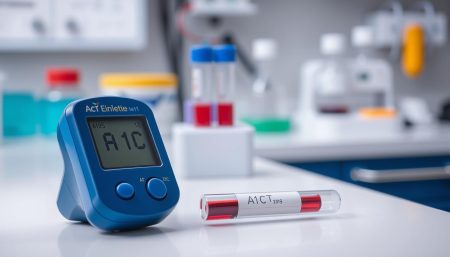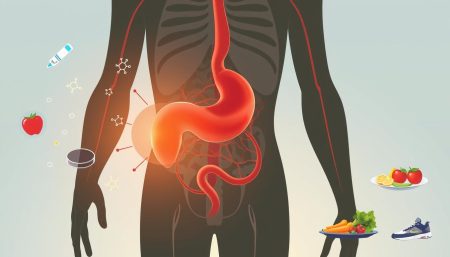Type 1 diabetes mellitus is a disorder that affects millions. It happens when the body can’t make insulin, causing blood sugar levels to rise. Managing this condition is key to staying healthy and requires careful blood sugar control.
If not managed well, Type 1 diabetes can lead to serious health problems. This makes education and awareness very important.
With the right blood sugar control and management, people with Type 1 diabetes mellitus can live full lives. Understanding the condition and using informed practices helps keep health in check and reduces risks.
This introduction is just the start of a detailed journey. We’ll explore everything from diagnosis to treatment options. We’ll also look at the autoimmune nature of the disease and its psychological impact. Each part will reveal the complexity of Type 1 diabetes mellitus and guide towards effective diabetes management.
Understanding Type 1 Diabetes Mellitus
Type 1 diabetes mellitus, also known as insulin-dependent diabetes, is an autoimmune condition. The pancreas fails to make enough insulin. Insulin is key for glucose to enter cells from the bloodstream.
Early understanding and management are vital. This includes consistent glucose monitoring. It helps maintain health and prevent complications.
What is Type 1 Diabetes?
Type 1 diabetes is when the pancreas’s beta cells are destroyed. This is usually due to an autoimmune response. The body’s immune system attacks these insulin-producing cells.
This leads to almost complete dependence on insulin from outside. Without proper treatment and monitoring, glucose regulation becomes challenging.
Differences Between Type 1 and Type 2 Diabetes
Type 2 diabetes can often be managed with lifestyle changes and medication. It usually develops in adulthood. Type 1 diabetes, on the other hand, is diagnosed in children and young adults.
Type 1 diabetes is strictly managed with insulin therapy. Patients with Type 2 diabetes usually produce insulin but can’t use it effectively. Type 1 patients produce little to no insulin due to autoimmune destruction.
The Role of Insulin in the Body
Insulin is a hormone that regulates blood glucose levels. It allows glucose to enter cells where it’s converted into energy or stored. For those with insulin-dependent diabetes, insulin from outside is a daily necessity.
It mimics the natural process and keeps glucose levels healthy.
| Parameter | Type 1 Diabetes | Type 2 Diabetes |
|---|---|---|
| Age of onset | Typically children and young adults | Mostly adults |
| Insulin Production | Little to none | Not efficient (insulin resistance) |
| Dependency on insulin | High (external insulin required) | Varies (may be managed with diet and medication) |
| Primary management method | Insulin injections or pump | Lifestyle changes, oral medications |
Symptoms of Type 1 Diabetes
It’s important to spot the early signs of Type 1 diabetes, mainly in kids. If not caught early, it can lead to serious health problems. Look out for signs like drinking a lot of water, going to the bathroom a lot, and losing weight without trying.
- Increased Thirst and Urination: High blood sugar makes the body get rid of extra glucose in urine. This leads to dehydration and a big increase in thirst.
- Unexplained Weight Loss: Even when eating more, weight loss happens because the body breaks down muscle and fat for energy it can’t get from sugar.
- Fatigue: Without enough energy from sugar, people often feel very tired and sluggish.
Being aware and watching for these signs is key to stopping diabetes from getting worse. Spotting them early means you can get help fast. This can make a big difference in someone’s life with juvenile diabetes.
| Symptom | Explanation | Immediate Action |
|---|---|---|
| Increased Thirst | Body loses fluids more quickly due to high blood sugar, creating a cycle of dehydration. | Intake of fluids; seek medical advice if persistent. |
| Frequent Urination | Excess glucose in bloodstream leads to more urine production to eliminate sugar. | Monitor fluid intake and urination frequency; consult a healthcare provider. |
| Weight Loss | Energy deficit due to the inability to use glucose effectively causes the body to metabolize fat and muscle instead. | Maintain a balanced diet and seek medical attention to evaluate unexplained weight loss. |
The Onset of Juvenile Diabetes
Type 1 diabetes mellitus, also known as juvenile diabetes, often starts in childhood or teens. It can be tough for young people and their families. Knowing when it starts and what might trigger it is key to managing it well. Starting insulin therapy early is very important in controlling the disease.
- Early signs include a lot of thirst, needing to pee a lot, and losing weight without trying.
- Children might seem more tired and cranky.
- Starting insulin therapy can help manage these symptoms well.
The emotional and social effects of type 1 diabetes mellitus on families are huge. It’s important to have both medical and emotional support right from the start. Keeping the disease in check also means watching and adjusting insulin therapy regularly, based on each child’s needs.
| Age Group | Symptoms at Onset | Initial Insulin Therapy Approach |
|---|---|---|
| Under 5 years | High irritability, Bed-wetting | Low-dose, frequent monitoring |
| 5-12 years | Frequent urination, weight loss | Structured insulin routine with diet adjustments |
| Teenagers | Rapid weight loss, fatigue | Intensive insulin management |
Dealing with type 1 diabetes mellitus from the start with good insulin therapy and careful management can make life easier for young patients. It’s vital to support kids and teens with the right resources and education about their condition. This helps them manage their disease well and live a better life.
Diagnosing Type 1 Diabetes Mellitus
Diagnosing diabetes is key to managing it. It involves several medical tests to find high blood sugar levels in Type 1 diabetes. Knowing these tests helps confirm the disease and plan the right treatment.
Medical Tests and Procedures
Screening for Type 1 diabetes starts with blood glucose tests. The fasting blood glucose test is often used first. It checks blood sugar after an overnight fast.
If the test shows high blood sugar, more tests are needed. A glycated hemoglobin (A1C) test is usually done next. It shows average blood sugar levels over two to three months.
Autoantibody tests are also important for diagnosing Type 1 diabetes. They check for immune system cells attacking insulin-producing cells in the pancreas.
Understanding Blood Sugar Levels
Managing diabetes well means watching blood sugar levels closely. Regular glucose monitoring and understanding blood sugar patterns are key. The A1C test is important here, showing how well current treatments are working.
For those just diagnosed, learning to manage high blood sugar is essential. This includes using glucose monitoring tools and making dietary and lifestyle changes.
Type 1 Diabetes Diabetes Mellitus: Management Strategies
Managing Type 1 diabetes well means keeping blood sugar in check, using insulin, and making a plan just for you. These steps help lower the risks of Type 1 diabetes and make life better for patients.
Insulin Therapy: Insulin is key in managing diabetes. It’s important to find the right insulin and how to use it for each person. New insulin types and ways to take them have made managing blood sugar easier and more effective.
Blood Sugar Monitoring: Checking blood sugar often is a must. People with Type 1 diabetes should use devices that show blood sugar levels in real time. This helps them make quick changes to their care plan.
Diet and Exercise: Eating right and staying active are big parts of managing Type 1 diabetes. Working with a dietitian can help make meal plans that keep blood sugar stable. A good exercise plan also helps keep blood sugar in check and improves overall health.
Technology Integration: New digital health tools make managing diabetes easier every day. Apps and devices that work with glucose monitors help track and share health data. This makes it easier to stay on top of diabetes care.
Creating a treatment plan that fits you means working with a team of healthcare experts. They make sure every part of your diabetes care is right for you.
| Management Strategy | Benefits |
|---|---|
| Customized Insulin Therapy | Improves blood glucose stability, reduces risk of complications |
| Continuous Glucose Monitoring | Provides real-time feedback, enhances blood sugar control |
| Digital Health Tools | Streamlines data management, improves communication with healthcare providers |
Advancements in Insulin Therapy
In recent years, insulin therapy has seen big changes. These changes have made life better for people with insulin-dependent diabetes. New technology has led to better ways to deliver insulin, making it easier to manage diabetes.
Fast-acting and long-acting insulin analogs are now available. They work like the body’s natural insulin, controlling blood sugar levels at meals and throughout the day.
Continuous glucose monitoring (CGM) systems have also changed the game. They let patients adjust their insulin doses based on real-time glucose readings. This helps avoid dangerous blood sugar levels.
- Insulin pumps that offer automated insulin delivery
- Smart insulin pens which record dose timings and amounts
- Biosimilar insulins that provide affordable options
| Technology | Benefits | Target Patient Group |
|---|---|---|
| Insulin Pumps | Continuous and controlled insulin infusion, integration with CGM | Patients requiring constant insulin administration |
| Smart Insulin Pens | Track and calculate doses, connect to mobile apps | Patients managing diabetes with lifestyle flexibility |
| Long-acting Insulins | Stable, all-day glucose control with fewer injections | Patients with significant basal insulin needs |
Importance of Blood Sugar Control
Managing diabetes well means keeping blood sugar levels in check. It’s key to avoid risks linked to high blood sugar. It also boosts health and well-being for those with diabetes.
The Glycemic Index and Diabetes
The glycemic index (GI) is a helpful tool for managing blood sugar through food choices. It shows how carbs affect blood sugar. Eating low GI foods helps keep blood sugar stable, which is vital for diabetes care.
Strategies for Maintaining Stable Blood Sugar
Checking blood sugar regularly and following a good diet are key. Also, regular exercise helps manage blood sugar well.
- Regular glucose monitoring helps in making informed decisions about diet and medication.
- Maintaining a diet low in high GI foods and rich in dietary fiber can promote a stable glucose level.
- Engaging in daily physical activity can improve insulin sensitivity.
| Strategy | Description | Benefits |
|---|---|---|
| Diet | Focus on low GI foods | Reduces spikes in blood sugar |
| Glucose Monitoring | Regular checks | Inform diabetes management decisions |
| Exercise | Regular physical activity | Improves blood glucose control |
Continuous Glucose Monitoring Systems
Continuous glucose monitoring (CGM) systems have changed how we manage diabetes. They give us real-time info on blood sugar levels. This makes controlling blood sugar easier and can work well with insulin therapy.
How CGM Works
A CGM system has a small sensor under the skin that checks glucose levels all the time. The info goes to a device, like a phone or a special receiver. This way, you can watch your glucose without having to prick your finger often.
The Benefits of CGM for Diabetes Management
CGM systems have many benefits for people with diabetes. They help avoid low blood sugar, make insulin therapy better, and give insights into glucose trends. This info lets you make quick changes to keep your blood sugar in check.
| Feature | Benefits |
|---|---|
| Real-time glucose data | Improves blood sugar control and reduces hypoglycemia risk |
| Integration with insulin pumps | Streamlines insulin therapy for optimal diabetes management |
| Trend alerts and predictions | Forecasts possible blood sugar level changes to take action early |
| Less frequent finger-pricking | Offers convenience and reduces discomfort from blood glucose tests |
Impact of Diet and Lifestyle on Type 1 Diabetes
Eating well and living healthily are key to managing diabetes. The right foods help keep blood sugar in check, which is vital for those with Type 1 diabetes. This part looks at how diet and lifestyle affect high blood sugar and health.
Eating foods like whole grains, veggies, lean meats, and healthy fats is important. These foods help control blood sugar better. Here are some tips for managing Type 1 diabetes through diet:
- Eat complex carbs like whole grains, which affect blood sugar less than simple carbs.
- Get enough fiber from veggies, nuts, and whole grains to help control blood sugar.
- Keep meal times and portions the same to avoid big blood sugar swings.
Being active is also key to managing diabetes. Exercise lowers blood sugar by making your body more sensitive to insulin. It’s good to do both cardio and strength training to control blood sugar better.
Also, having a routine and not stressing too much helps keep blood sugar stable. Getting enough sleep and using stress-reducing activities like yoga and mindfulness is good for your overall health and managing high blood sugar.
| Dietary Element | Benefits |
|---|---|
| Whole grains | Improves blood sugar control due to high fiber content |
| Lean Proteins (Chicken, Fish) | Helps manage hunger without causing blood sugar spikes |
| Healthy Fats (Avocados, Nuts) | Reduces glycemic index of meals |
By eating right and staying active, managing Type 1 diabetes gets easier. Focusing on these areas can improve your life and make managing high blood sugar less of a challenge.
Understanding the Autoimmune Aspect of Type 1 Diabetes
Type 1 diabetes is an autoimmune disease. It happens when genes and environment combine to destroy insulin-making cells in the pancreas. We’ll explore how this happens and what factors contribute to it.
Autoantibodies and Beta-Cell Destruction
In Type 1 diabetes, the immune system attacks and kills beta cells in the pancreas. This is because of autoantibodies. Without these cells, the pancreas can’t make enough insulin. Researchers find these autoantibodies before diabetes symptoms show up.
Genetic and Environmental Factors
Genes play a big role in getting Type 1 diabetes. But, not everyone with these genes will get the disease. Things like viruses, diet, and early exposure can start the autoimmune attack in those at risk. Knowing about these factors helps us find ways to stop autoimmune diabetes.
Dealing with autoimmune diabetes means more than just controlling blood sugar. It’s about understanding and controlling the immune system’s attack on the pancreas. This approach can stop the disease from getting worse, improve life quality, and predict better outcomes for those with it.
Exercising with Type 1 Diabetes
Regular physical activity is key for everyone, including those with Type 1 diabetes. It boosts health and helps manage diabetes better. But, it’s important to plan exercise with glucose monitoring to stay safe and effective.
Physical Activity Recommendations
People with Type 1 diabetes should do at least 150 minutes of moderate to vigorous exercise weekly. Activities like brisk walking, swimming, cycling, or running are good. Strength training two days a week also helps improve insulin sensitivity and muscle glucose uptake.
Before starting any new exercise, it’s important to talk to a healthcare provider. They can help choose activities that fit your health and fitness level.
Exercise Precautions and Blood Glucose Monitoring
Exercise is good, but it needs careful glucose monitoring. Blood glucose levels can change during and after exercise. This can cause hypoglycemia or hyperglycemia.
To avoid these issues, check blood glucose levels before, during, and after exercise. You might need to adjust your carb intake or insulin doses. Also, remember to drink plenty of water and watch for signs of glucose imbalance like fatigue, confusion, or dizziness.
To learn more about managing glucose and insulin levels during physical activities and other diabetes care, visit understanding diabetes management and hair loss. It offers valuable insights.
Following these guidelines makes exercise a helpful tool in managing Type 1 diabetes. It improves quality of life and keeps blood glucose levels in check. Remember, always talk to your healthcare team to get the best results.
Challenges in Day-to-Day Management
Living with diabetes mellitus means always being careful and having a good plan to keep blood sugar in check. It’s important to watch glucose levels closely, control diet, and understand how different things affect blood sugar.
One big challenge is keeping blood sugar levels right to avoid too high or too low. High blood sugar can cause serious problems if not managed well. This shows why it’s key to monitor glucose levels well.
To manage diabetes, people often use a mix of tracking by hand and technology. New tools like continuous glucose monitoring systems help track blood sugar levels in real time. This helps make better choices about what to eat, how much to exercise, and when to take insulin.
- Diet: Planning meals carefully is needed to keep blood sugar stable.
- Insulin Dosing: Getting the right amount of insulin can be tricky because of many factors like stress and activity.
- Emotional Impact: Managing diabetes can also affect a person’s mood and mental health.
It’s also important to fit diabetes care into daily life, including work and social activities. This can help avoid feelings of loneliness or not being understood about managing high blood sugar. It affects how we interact with others and how well we do at work.
| Factor | Challenge | Strategies |
|---|---|---|
| Daily Monitoring | Constant need for blood sugar checks | Use of CGM devices for continuous data |
| Nutrition | Balancing diet for blood sugar control | Structured meal planning and professional dietary advice |
| Exercise | Adjusting insulin and food intake around activity | Regular consultation with a diabetes educator |
| Workplace Integration | Maintaining privacy and managing symptoms at work | Education sessions for colleagues, flexible working conditions |
Managing diabetes every day requires being proactive and often a team of healthcare professionals. Thanks to new technology, people with diabetes have better tools and support. This means they can live a better life.
Preventing and Managing Diabetic Complications
Managing Type 1 diabetes well is key to avoid or delay serious health issues. These issues can affect many parts of the body. They include heart problems and nerve damage, showing why keeping blood sugar in check is so important.
Common Long-Term Complications
Diabetes can harm vital organs over time. Some major problems are:
- Neuropathy – nerve damage in limbs, causing numbness, pain, and weakness.
- Nephropathy – kidney damage that can lead to kidney failure if not treated.
- Retinopathy – eye damage that can cause vision loss.
- Cardiovascular diseases – higher risk of heart attacks and strokes.
Keeping blood sugar under control with the right insulin plan can greatly reduce these risks.
Screening and Early Intervention Strategies
Screening for diabetes complications is essential for those with Type 1 diabetes. Finding problems early is key to managing and treating them. Here are some strategies:
- Regular blood pressure and cholesterol checks.
- Annual eye exams to check for eye damage.
- Bi-annual tests to check kidney function.
- Regular foot checks to spot early signs of nerve damage.
These health checks are important for catching diabetic complications early. This allows for timely treatment.
The Psychological Impact of Living with Type 1 Diabetes
Living with type 1 diabetes, also known as juvenile diabetes, is more than just managing the disease physically. It deeply affects the mental and emotional sides, bringing unique challenges. This part looks into the big psychological effects on those with autoimmune and juvenile diabetes.
Depression, Anxiety, and Diabetes Burnout are common for those with autoimmune diabetes. The stress of checking blood sugar, taking insulin, and eating right can really hurt mental health.
- Depression often goes hand in hand with diabetes, so it’s key to spot the signs early.
- Anxiety can show up as constant worries about blood sugar and future health problems.
- Diabetes burnout is feeling tired and frustrated from always watching your blood sugar.
To manage diabetes well, dealing with these mental stresses is just as important as staying physically healthy. Having a support system, like counseling and groups, is vital for easing mental pressure.
The table below shows ways to boost mental health for those with juvenile diabetes:
| Mental Health Issue | Coping Strategy | Resources |
|---|---|---|
| Depression | Regular sessions with a psychologist | Social workers specialized in chronic diseases |
| Anxiety | Mindfulness techniques, Cognitive Behavioral Therapy | Online platforms for mental health therapies |
| Diabetes Burnout | Joining support groups, taking breaks from diabetes care | Community centers, online forums |
Adding these mental health strategies to diabetes care improves mental strength and overall health. Understanding and tackling the mental side of type 1 diabetes is key for patients and caregivers.
Support Systems and Resources for Individuals with Type 1 Diabetes
Managing juvenile diabetes is easier with strong support systems. These systems offer emotional, educational, and practical help. They are key to understanding and managing diabetes.
Finding Community Support
Support groups are vital for those with diabetes. They let people share experiences and learn from each other. This support is essential for managing diabetes well.
Utilizing Online Resources and Technologies
Digital technology has made managing type 1 diabetes easier. Online resources provide tools like tracking blood sugar and talking to doctors online. This makes managing diabetes more accessible than before.
- Interactive apps for managing diet and medication
- Online forums that connect diabetics worldwide
- Virtual health services for regular consultations

| Feature | Benefit |
|---|---|
| Real-time glucose tracking apps | Helps in timely adjustments of insulin and diet |
| Online dietary planners | Assists in maintaining balanced nutrition, which is key for diabetes management |
| Virtual peer support groups | Provides emotional support and shared learning |
These online resources improve self-management and support overall diabetes management. They combine community wisdom with modern technology.
Research and Future Trends in Type 1 Diabetes Care
The world of type 1 diabetes mellitus is on the verge of a big change. New research and tech are making diabetes management better. Targeted immunotherapies are a big hope. They aim to stop the immune system from attacking the pancreas.
These treatments could change the disease’s course or even prevent it. Researchers are excited about the chance of finding new ways to help.
Beta-cell replacement therapy is also making progress. It aims to fix insulin production by adding new cells or regrowing old ones. There are hurdles like immune rejection and finding enough cells, but trials are moving forward.
Artificial pancreas systems are also improving. They use sensors and pumps to control insulin better. This means patients can live more freely without constant worry.
The ultimate goal is to find cures, not just manage symptoms. These new treatments and devices could make life easier for those with type 1 diabetes diabetes mellitus. Success depends on teamwork between scientists, tech creators, and doctors.
FAQ
Q: What is Type 1 Diabetes Mellitus?
A: Type 1 Diabetes Mellitus is a chronic condition where the body can’t make insulin. This leads to high blood sugar levels. It needs careful management through insulin therapy and lifestyle changes.
Q: What distinguishes Type 1 from Type 2 diabetes?
A: Type 1 diabetes is an autoimmune condition where the body attacks insulin-producing cells. This makes it insulin-dependent. Type 2 diabetes, on the other hand, is often linked to insulin resistance and lifestyle factors.
Q: Why is insulin so important in the body?
A: Insulin helps control blood sugar levels by helping cells use glucose for energy. Without it, glucose builds up in the blood, leading to serious health issues.
Q: What are common symptoms of Type 1 Diabetes?
A: Symptoms include excessive thirst, frequent urination, sudden weight loss, and fatigue. Blurred vision and slow-healing sores are also common. Early recognition is key to managing the condition.
Q: How is juvenile diabetes typically detected and treated?
A: Juvenile diabetes is detected through symptoms and blood tests. Treatment involves lifelong insulin therapy, monitoring blood sugar, and a healthy diet.
Q: What tests are used to diagnose Type 1 Diabetes Mellitus?
A: Blood tests check for high sugar levels and autoantibodies. Glycated hemoglobin (A1C) tests assess long-term blood sugar control.
Q: What strategies are essential for managing Type 1 Diabetes?
A: Key strategies include regular insulin therapy, dietary adjustments, and physical activity. Monitoring blood sugar levels and maintaining a healthy lifestyle are also important.
Q: What recent advancements have been made in insulin therapy?
A: Recent advancements include rapid-acting insulin and long-acting insulin analogs. Insulin pumps and smart pens offer more precise dosing.
Q: How does the glycemic index help in managing diabetes?
A: The glycemic index ranks carbs by their effect on blood sugar. Choosing low glycemic index foods helps maintain stable blood sugar levels.
Q: What are the benefits of continuous glucose monitoring (CGM) systems?
A: CGM systems provide real-time blood sugar readings. They help identify patterns, reduce hypoglycemia, and improve diabetes management.
Q: How does diet and lifestyle affect Type 1 Diabetes management?
A: Diet and lifestyle are critical in managing Type 1 Diabetes. Healthy eating, exercise, and routines can improve blood sugar control and overall health.
Q: How does Type 1 Diabetes function as an autoimmune condition?
A: Type 1 Diabetes occurs when the immune system attacks insulin-producing cells. Genetics and environmental factors can trigger this autoimmune process.
Q: What recommendations exist for exercising with Type 1 Diabetes?
A: Regular physical activity tailored to individual needs is recommended. Monitoring blood sugar before, during, and after exercise is also important.
Q: What are the daily challenges of managing Type 1 Diabetes?
A: Daily challenges include adjusting insulin doses, managing diet, and monitoring glucose levels. Coping with the emotional and physical stress of a chronic condition is also a challenge.
Q: How can diabetic complications be prevented or managed?
A: Complications can be prevented or managed by maintaining strict blood sugar control and regular health screenings. Early intervention and a healthy lifestyle are also key.
Q: What is the psychological impact of living with Type 1 Diabetes?
A: Living with Type 1 Diabetes can lead to stress, anxiety, depression, and burnout. Psychological support, support groups, and stress management can help cope with these issues.
Q: Where can individuals with Type 1 Diabetes find support and resources?
A: Support and resources are available in community groups, online platforms, educational materials, and advanced diabetes management technologies.
Q: What does the future hold for Type 1 Diabetes care?
A: Research is ongoing to improve Type 1 Diabetes care. This includes immunotherapy, beta-cell transplantation, and the development of artificial pancreas systems to enhance insulin therapy and quality of life.


















